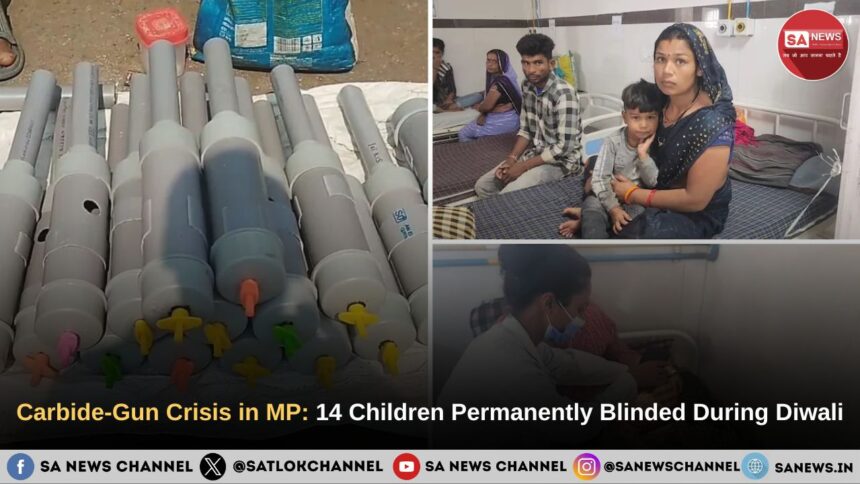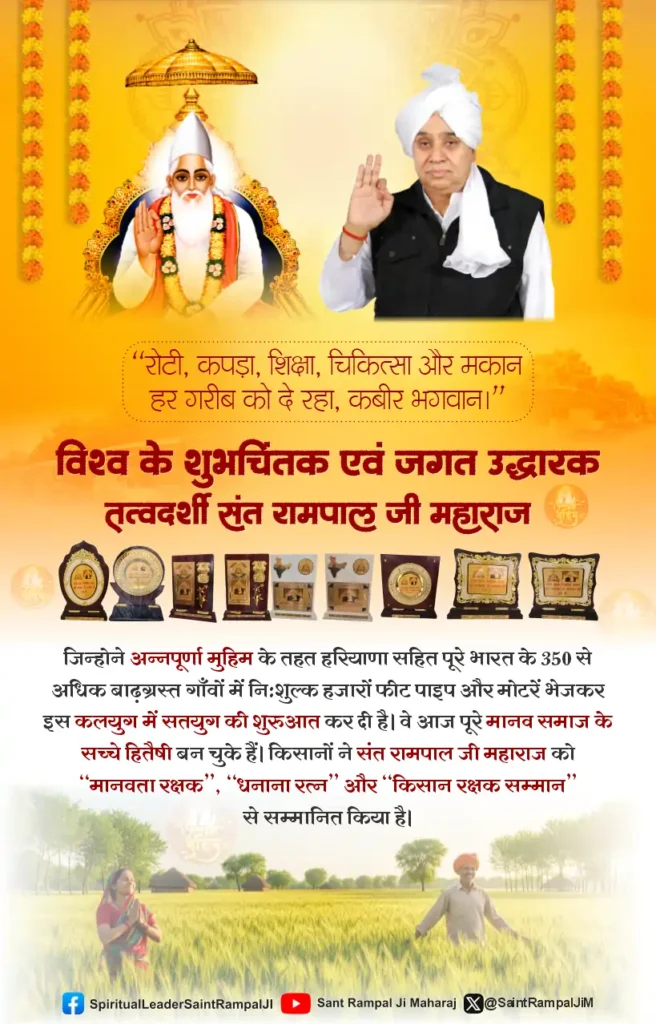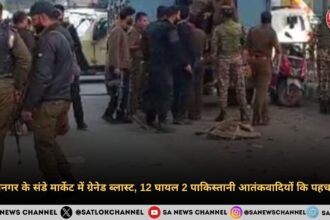Carbide Guns Tragedy: Diwali 2025 celebrations in the central Indian state of Madhya Pradesh took a tragic turn when homemade devices known as “carbide guns” caused hundreds of eye injuries – including at least 14 children losing their sight permanently. Experts, authorities and families alike are sounding the alarm over a dangerous trend combining chemical misuse, online marketing and child curiosity.
- What Are “Carbide Guns” and How Do They Cause Injury?
- Scale of the Crisis: Injuries and Permanent Vision Loss
- Social Media, Viral Challenges and the Role of Illegal Sales
- Legal Status & Government Response
- Why the Damage is Worse Than Regular Fireworks
- Voices from the Ground: Children, Families & Medical Experts
- What Should Parents, Schools and Policy-Makers Do?
- Long-Term Implications for Public Health & Safety
- Spiritual Diwali Meaning: How True Knowledge Prevents Tragic Injuries
- FAQs on Carbide-Gun Crisis in Madhya Pradesh
- Q: What caused multiple children to lose eyesight in Madhya Pradesh during Diwali 2025?
- Q. How do carbide guns work and why are they dangerous?
- Q. How many children were injured or blinded in Madhya Pradesh this Diwali?
- Q. What is the legal status of carbide guns in India and Madhya Pradesh?
- Q. What steps are authorities taking to stop the sale and use of these devices?
What Are “Carbide Guns” and How Do They Cause Injury?
“Carbide guns” are improvised explosive devices made using plastic or tin pipes, calcium carbide and water. When water contacts calcium carbide, acetylene gas is produced; a spark then triggers a violent explosion that ejects fragments and releases toxic vapours.
Medical professionals report that these devices behave unlike conventional firecrackers:
- They expel shrapnel-like fragments from the pipe, often aimed at the face and eyes.
- The intense blast, hot gases and flying debris lead to corneal burns, ruptured pupils and retinal damage – in some cases irreversible blindness.
Hence, the ‘toy-cannon’ moniker belies their acute danger to children.
Scale of the Crisis: Injuries and Permanent Vision Loss
The numbers emerging from Madhya Pradesh paint a startling picture:
- Across the state, about 300 people suffered eye injuries from carbide guns during the Diwali period.
- In the city of Bhopal, at least 186 cases of eye injuries were reported.
- Hospitals treating children in the age group 8–14 reported large influxes of patients.
- According to news reports, 14 children lost their eyesight permanently after using these carbide guns.
- In one district, Vidisha, local markets openly continued selling these devices despite a ban.
These figures underscore a vivid public-health emergency – not merely isolated incidents.
Social Media, Viral Challenges and the Role of Illegal Sales
Children and teenagers were reportedly influenced by short-form social media videos and viral “challenges”, leading them to treat carbide guns as experimentable fire-crackers.
Investigations revealed that:
- The devices sold for Rs 150–200 in local markets.
- Some were advertised and procured via online platforms and social-media channels.
- Enforcement orders had been issued on 18 October but were flouted in some districts.
Thus, the deadly combination of social appeal + low cost + weak enforcement created a perfect storm.
Legal Status & Government Response
In response to multiple cases:
- The district collector of Gwalior imposed a complete ban on manufacture, sale and purchase of carbide guns.
- Police in Bhopal seized dozens of devices and initiated FIRs under the Bharatiya Nyaya Sanhita Section 288 (negligent conduct with explosives).
- Hospitals and health-authorities activated reserved beds to treat cases of eye injuries.
- However, enforcement faces challenges: online ads, grey-market supply and low awareness among children remain significant hurdles.
Why the Damage is Worse Than Regular Fireworks
Unlike regulated legal firecrackers, carbide guns bypass safety checks and regulations. Key distinctions:
- Proper fireworks are subject to manufacturing standards and regulations; carbide guns are improvised.
- The blast often occurs at point-blank range, aimed at face/eyes.
- The chemical reaction is uncontrolled; the presence of metal shards and plastic pipe debris exacerbates injury.
- Medical authorities emphasise that treatment is more complex: retinal burns, corneal perforation and risk of permanent blindness rather than temporary injury.
Voices from the Ground: Children, Families & Medical Experts
“We bought a homemade carbide gun. It exploded in my face. I can’t see anything with one eye.” – A teenage victim in Vidisha.
Medical experts at Hamidia Hospital and other eye-wards in Bhopal reported treating numerous cases where pupils were ruptured and permanent sight loss was anticipated. Families are demanding compensation, stricter bans and enforcement. One father said: “Such guns should not be sold in the market in the first place.”
What Should Parents, Schools and Policy-Makers Do?
For parents & guardians:
- Educate children that “novel fire-crackers” circulating on social media may not be toys – they are improvised explosives.
- Monitor children’s online behaviour, short-video viewing and peer pressure around fire-cracker “challenges”.
- Store legal, regulated crackers safely; if you suspect a device is homemade or using chemicals such as calcium carbide, do not permit its use.
For schools & community groups:
- Run awareness sessions ahead of festivals: explain how calcium carbide reaction works and why eye injuries occur.
- Encourage safe alternatives: green crackers, sparkler-free zones, supervised community events.
- Collaborate with local hospitals to provide emergency contact lists and first-aid awareness for eye injuries.
For policy-makers & law enforcement:
- Strengthen monitoring of online advertisements and e-commerce platforms for banned fire-cracker devices.
- Impose stricter supply-chain checks in festival-period hotspots and rural-urban fringe markets.
- Ensure adequate medical preparedness in districts: reserve eye-wards, stock corneal-burn treatment kits and establish referral protocols for retinal damage.
- Introduce visible penalties for illegal manufacture and sale of carbide guns; ensure that enforcement is communicated widely pre-festival.
Long-Term Implications for Public Health & Safety
The scale of the injuries during one Diwali season in Madhya Pradesh signals broader implications:
- Public health burden: Severe eye injuries lead to long-term treatment costs, disability, psychological impact and loss of vision.
- Regulatory gap: The continued sale of banned devices despite pre-festival warnings highlights enforcement lapses and the role of informal markets.
- Digital age risk: Social-media-driven fire-cracker trends escalate danger, emphasising the need to integrate digital-safety messages into festival-safety campaigns.
- Educational loss: Blinded children face lifelong challenges – education, employment, mobility – all impacted by preventable festival-related injuries.
Spiritual Diwali Meaning: How True Knowledge Prevents Tragic Injuries
The painful incident of children losing their eyesight due to banned carbide guns shows how far we have drifted from the true essence of Diwali. Diwali was never meant to harm; it was a festival of light, love, and the return of righteousness when Lord Ram came back to Ayodhya.
As Almighty Kabir Sahib beautifully said,
Sada Diwali sant Kee, Barah maas basant,
Prem rang jin par Chadhe, Unaka rang Anant.
For true saints and devotees, every day is Diwali because their hearts are filled with the light of divine knowledge. Sant Rampal Ji Maharaj Ji explains that real Diwali is celebrated within, by removing the darkness of ignorance and lighting the lamp of true worship of the Supreme God Kabir. When we adopt His teachings of peace, compassion, and devotion, every day becomes a festival. True joy is not in fireworks but in awakening the soul with God’s eternal light.
FAQs on Carbide-Gun Crisis in Madhya Pradesh
Q: What caused multiple children to lose eyesight in Madhya Pradesh during Diwali 2025?
During Diwali 2025 in Madhya Pradesh, children used illegal homemade “carbide guns” made of plastic/tin pipes and calcium carbide. The chemical reaction with water releases acetylene gas, causing an explosion that resulted in severe eye injuries and at least 14 children losing their sight permanently.
Q. How do carbide guns work and why are they dangerous?
Carbide guns are homemade devices made from pipes filled with calcium carbide and water. When these react, they release acetylene gas, which explodes when ignited. The blast can cause severe eye, face, and hand injuries due to shrapnel, hot gases, and high-pressure shockwaves.
Q. How many children were injured or blinded in Madhya Pradesh this Diwali?
During Diwali 2025, over 300 eye-injury cases were reported across Madhya Pradesh, including 186 in Bhopal alone. At least 14 children have been confirmed permanently blinded after using banned carbide guns.
Q. What is the legal status of carbide guns in India and Madhya Pradesh?
Carbide guns are illegal in India. Their manufacture, sale, and use are banned under the Explosives Act and local district orders in Madhya Pradesh. Authorities classify them as hazardous explosive devices, not firecrackers.
Q. What steps are authorities taking to stop the sale and use of these devices?
Police have banned sales, seized stock, and arrested several sellers in Bhopal, Vidisha, and Gwalior. Crackdowns now extend to online ads and social-media sales, with awareness drives launched in schools and communities to warn children and parents.









